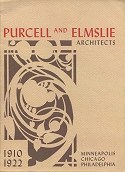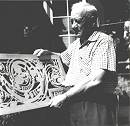|
|
|
Purcell and Elmslie, Architects Firm active :: 1907-1921
Minneapolis, Minnesota :: Chicago,
Illinois |
Ye Older Grindstones
7/22/2003
Catalog cover
Walker Art Center exhibition, 1953
Masonite panel from the Traveling Exhibition with a rendering for the J. E. Meyers residence, project,
as glued on by Elmer and John Jager
Part of a masonite panel with a drawing showing the floor plan for the James E. Moore residence, project
Fred A. Strauel, ca. 1974, with the sawed wood panel made by K. Paul Carson for the exhibitionWatershed. The early 1950s moved P&E toward an endgame: winning the lasting reputation that is usually a principal product of scholarly evaluation in a museum environment, to wit the "Purcell & Elmslie, Architects" Exhibition held at the Walker Art Center in 1953. The records of the firm, at least those which remained in Minneapolis since the closing of the toehold maintained by longtime drafter Fred Strauel in the late 1920s at the Architect's and Engineers' Building, had long since been trucked to the basement of John Jager's house on Red Cedar Lane (an earlier Grind touches on this). Under the critical eye of Jager, the handiness of Strauel, and the prying of a doctoral candidate named David Gebhard, out of this primordial mass came the archival materials that together with some sawed wood, leaded glass, furniture, and textiles constituted the first major academic showing of the firm's work.
The show was curated by Walker staff, whose budget did not afford a catalog. Purcell, however, deemed this too gross an oversight and offered to defray the expense. As the main contributor (some said angel, one at least commented devil and Purcell gleefully published his letter saying so) of Northwest Architect [NWA], Purcell arranged for the catalog to be designed and printed in conjunction with a special issue of NWA at the Bruce Publishing Company where the Minnesota Society of Architects journal was produced. By remote control through a barrage of memos and letters from his Westwinds estate in California, WGP did his best to ensure that the catalog carried on the graphical standards he had been developing for over forty years toward presenting in print the work of the firm. The result was 4,000 copies of a 12 page handout with a nice textured tan paper cover printed in two colors, including the silhouette of a fine sawed wood diagram by Elmslie that Purcell commented was his favorite.
Of course, there was many a slip--or at least one or two [where is Mr. Feick?]--with the usual rush of museum staff to make sure the publication met their needs and appeared according to their own protocols, while Purcell insisted via express mail what considerations were really important. Naturally, right off, there was an issue of--you guessed it--proper credit. Inside a paragraph states: "The exhibition and catalogue were directed by Norman C. Nagle, Curator. The cover was designed by William Gray Purcell, and the layout and typography were executed by Ruth Dean." Such an innocent effort at recognizing Purcell's effort to decorate the cover, if omitting any mention of his financial support to produce the catalog. But, alas, interpretation is everything. In his own view, Purcell now had a minimum of 4,000 people out there thinking he was laying claim to authorship of one of Elmslie's creative enrichments. Memos flew.
The opening of the exhibition included a talk by Gebhard leading off about the Secessionists in Vienna (I have thought from time to time that the first celebration of an American firm dedicated to the fresh expressions of democratic ideals warranted launching with something other than an invocation of the fin de sicle Hapsburg imperial capitol, but what do I know?). Dr. Carson stood duly by to capture the whole thing with his tape recorder, a recording now probably rendered unplayable by the decay phenomenon of atmospheric off-gassing which causes the magnetic medium to detach from the underlying strip of acetate and form a finger-lickin' gunk on the player head. Everyone afterwards adjourned to the esteemed upscale but now demolished Charlie's Restaurant in downtown Minneapolis to feast on lobster and steak. Elmslie, of course, had irascibly died just one year earlier, though he might have been spiritually in attendance to receive AT LAST some credit or, possibly, complain about that blurb in the catalog. Semi-invalid Purcell could not manage the travel necessary to be there (in just two short years he would be forced to give up his writing for NWA altogether, as his nemesis tuberculosis flared up). Jager compensated by sending him a menu annotated with comments on both the food and the people at the table.
By all measures, the show was a great success. The galleries attracted remarkably large crowds for an architecture show, including Purcell client J. Paul Carson who photographed everything with a 3-D camera. A dentist with a love of woodworking, Carson had also made a copy of the "Gray Days and Gold" sawed wood panel at Lake Place for display in the show which was later latched onto by Fred Strauel as his own personal souvenir (earlier noted). In what was a "best effort" at the time, Jager had mounted many of the delicious P&E colored pencil renderings on masonite boards underneath a heavy cover of--gulp--Elmer's glue. His intention was to preserve them forever, or at least prevent their decay as they were loaded into the wooden cases he constructed for the Traveling Exhibition that toured architectural campuses for the next two or so years. The downside is that these drawings are indeed forever pasted onto the boards, capturing a frozen slice of didactic determination in their permanent association with blacklines of working drawings and various photographs.
My own tail end encounter with the Walker exhibition reverberates down to 1981, when I went to Santa Barbara for a visit with David Gebhard. As we sat in his library, surrounded by the many P&E items he had collected [such a nice, unassuming word, unlike, say, hoarded] over the years, Gebhard abruptly ragged on me by saying "you have a lot to answer for, young man, in publishing that statement." Whatever that was. Of course, further inquiry established that I had in fact published nothing at all and Gebhard was confusing me with someone else entirely. Once past those shoals, he alluded in a dark voice that Purcell's personal relationships with people were "sometimes embarrassing." Not withstanding the recent weather in the library, what, I wondered, could Gebhard be referring to? Come to find out, there was the small matter of the bill for the Walker catalog. WGP did indeed offer to pay for the printing in a letter to the museum, a copy of which survives in the Purcell Papers and no doubt the institutional archives of the Walker. Yet, when the $700 bill arrived, the amount so stunned Purcell that he hemmed and hawed about such a princely amount being beyond the purse of one individual. Eventually he did pay the whole thing, but not without a little kicking and screaming by way of the US Post Office.
For much recollection of the history related above I find myself indebted to a former incarnation of Mark Hammons who had the [accidental?] wit to record all this some 20+ years ago when handling the original documents amid lingering frustrations with Gebhard. Those hardscrabble notes somehow survived in an old folder with early drafts of the Guide to the William Gray Purcell Papers. I don't know whether to be amazed, saddened, or horrified by how much detail I have forgotten. Perhaps all three. And I wonder what to do with these various folders of notes and old drafts of the Guide, either. Produced before word processors gained sway, they are long since much obsolesced by electronic versions (a kind of paper-based off-gassing, in a way). It seems ironic to consider just throwing them away.




